The concept of running Engineering Simulations on “somebody else’s computer” is not new. Many experienced analysts, of a certain age, will tell you stories of taking punched cards to a bureau computer back in the day and the frightening costs of computer time. Those stories of course date back to the 1970s and early 80s when very few people had a computer on their desk and even if they did, it wouldn’t have been capable of running simulations.
Things changed in the late 80s with the introduction of workstations and high-end PCs, and simulation increasingly came in house. The state of the art has progressed steadily to where we are today, with most engineering organisations having multiple machines capable of running highly advanced simulations with users’ desktop machines handling routine work.
However, there is still room for improvement. In most cases of high-fidelity simulation, analysts still need to carefully consider hardware capacity and run times when building models, making assumptions and segmenting the problem to be solved to obtain an acceptable level of accuracy in an acceptable time. IT departments typically have to procure and maintain non-standard hardware for simulation often leading to an uneasy relationship with analysts. Hardware and software licensing schemes traditionally have not had flexibility to cope with peaks and troughs in demand. Engineers are increasingly working in geographically dispersed teams, reducing the benefit of on-site hardware, and presenting barriers to collaboration. As models move closer to the real world they also become larger and more complex, the quantity of data increases as does the value of the IP associated with the model, however management of simulation data is still not widely deployed or adopted.
Over the last decade or so, the Cloud has emerged as a solution to many of these problems. Initially this was through specialist IT companies but more recently major CAE (Computer Aided Engineering) software providers have developed their own solutions. Amongst other things, the Cloud offers almost unlimited high-performance computing on demand, flexible licensing, centralised securely managed data and technologies for collaboration.
However, the level of uptake of these new solutions by the CAE user community is uncertain, so during October The Engineer magazine ran a survey, sponsored by SIMUSERV, to understand the current attitudes to Cloud Based Simulation. Below we discuss the findings of this survey and what they could mean for the adoption of the Cloud as a platform for Engineering Simulation.

Approximately a third of ENGINEERS are using the Cloud for Simulation
10 per cent said their simulation was fully Cloud based and 25 per cent said they made partial use of Cloud simulation tools. This suggests that a transition is certainly underway but still has a long way to go. In many ways this is not surprising as the main CAE vendors are relatively recent entrants into the Cloud domain, and it seems likely that the close integration of tools with the Cloud infrastructure is likely to be required to drive mass adoption.

Solutions from the main CAE Software Vendors account for the majority of usage.
38 per cent of usage centred around solutions from the main CAE Software Vendors with specialist simulation Cloud vendors making up 16 per cent. There was a long tail of “other” simulation solutions on the Cloud. This is interesting as the early entrants to this area were the specialist companies, however it’s possible that a focus by these companies on the larger simulation users could distort the picture here somewhat. The CAE vendors have the advantage that it is their software environment deployed by the users and thus there is the opportunity for closer integration with their Cloud solution and a more seamless workflow.
For example, some tools now offer the streaming of model and results data to and from the Cloud removing the need for distinct upload and download steps involving entire data sets. This can make the use of the Cloud almost transparent to the user.

There is a wide use of the Cloud for other tasks
The Cloud is in use within the majority of Companies. 65 per cent use it for file storage/transfer and 17 per cent use Cloud based CAD with only 17 per cent saying that they did not use the Cloud at all. This is encouraging as it seems to suggest a reasonable level of acceptance of the Cloud. Rightly or wrongly, applications such as file transfer and CAD often have more organisational reach than simulation and this could be a reason why they have been adopted earlier. This also does tend to suggest that security concerns are being addressed.
The potential benefits are well understood
60 per cent said the availability of High-Performance Computing and Collaboration were key perceived benefits and 56% also stated Flexible Software Licensing and Data Management.
All these capabilities are provided by a Cloud Based Simulation Platform accessible by all users in a managed way. The optimum hardware may be assigned for each simulation task to minimise runtimes which, coupled with a consumption-based licensing model, can reduce simulation costs. The data can be accessed by all authorised users using both lightweight visualisation tools in addition to more complex model building tools, expanding the organisational reach of simulation data.

There are still some perceived drawbacks
Somewhat surprisingly 60 per cent stated cost as a drawback, this may be due to the overlap expected between an on-premise and on-Cloud solution. 44 per cent stated data upload and download as a concern and 36% expressed worries around the support for custom software environments.
Security is a concern
Overall 86 per cent stated that security was a concern to some level. However, considering the responses in other areas, it’s clear that this is not stopping people from storing data on the Cloud. The security of data is rightly a prime concern whether it is stored on-site or on the Cloud and new challenges emerge constantly. There is certainly an argument that the enhanced security architecture and procedures deployed by Cloud providers could mean that data is better protected on the Cloud.

A Majority expect to be using the Cloud for Simulation within five years
Only 14 per cent said that they did not expect to be using the Cloud within 5 years and thus it appears that the general feeling is that the perceived benefits are real and the barriers to adoption can be overcome. As Cloud offerings become better integrated with existing tools and processes it seems reasonable that the pace of adoption will increase. The increasing focus of the major CAE vendors is probably key here.
Download the full survey report here
Conclusion
This survey has revealed interesting results. Perhaps unsurprisingly data security is a major concern and this may be the largest barrier to adoption of the Cloud for Simulation. However, the wider use of the Cloud for File Storage and other applications, such as CAD, suggests that this will gradually be overcome. Other perceived drawbacks, such as the transfer of data to and from local machines and user inertia may increasingly be addressed as the main CAE vendors produce Cloud integrated applications that stream data offering a seamless experience. The potential benefits appear to be well understood so increasing adoption of the Cloud for Simulation should be expected.










IET sounds warning on AI doll trend
I agree that we need to reduce cooling water demand for servers. And yes, generative AI consumes a large amount. But what about BitCoins? Their...